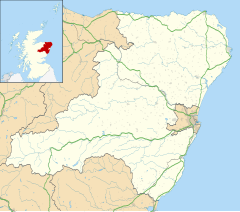Fordoun (Scottish Gaelic: Fordun) (Pronounced "For-Dun") is a parish and village in Aberdeenshire, Scotland. Fothirdun (possibly "the lower place"), as it was historically known,[citation needed] was an important area in the Howe of the Mearns. Fordoun and Auchenblae, together with their immediate districts form the Parish of Fordoun with the Parish Church[1] in the vicinity of the original settlement, now absorbed by Auchenblae.
Fordoun
| |
|---|---|
Location within Aberdeenshire | |
| OS grid reference | NO750758 |
| Council area | |
| Lieutenancy area | |
| Country | Scotland |
| Sovereign state | United Kingdom |
| Postcode district | AB30 |
| Dialling code | 01561 |
| Police | Scotland |
| Fire | Scottish |
| Ambulance | Scottish |

In the 19th Century Fordoun railway station was opened approximately 3 miles to the South East of Fordoun Church and the original settlement. A village grew at the site of the station (opened in November 1849 and closed in June 1956),[citation needed] where there was also a number of shops, but only a seasonal farm shop remains.[2] In the time since the founding of the railway station the village formerly known as Fordoun Station has come to be known simply as Fordoun and the site of the original settlement has been absorbed by Auchenblae.
People from Fordoun
edit- John of Fordun (d. c. 1384), Scottish Chronicler was born in the Parish of Fordoun.[3]
- George Wishart (ca.1513 – 1546) a Scottish Protestant Reformer and one of the early Protestant martyrs burned at the stake as a heretic.[4]
- John Wishart of Pitarrow (died 1576), a son of John Wishart of Cairnbeg in Fordoun parish, and comptroller of the Scottish exchequer.
- James Burnett, Lord Monboddo (1714–99), judge on the Court of Session lived at Monboddo House. He was author of The Origin and Progress of Man and Language, a study of evolution that predated the work of Charles Darwin.[5]
- James Beattie (1735–1803), Scottish scholar and writer was born in Laurencekirk and first worked as schoolmaster in Fordoun. He became Professor of Moral Philosophy and Logic at Marischal College and is noted for his Essay on the Nature and Immutability of Truth (1770) and poem The Minstrel.[6] [7]
- Alexander Hamilton (1739-1802) co-founder of the Royal Society of Edinburgh, one of the first doctors to recognise the infectious nature of puerperal fever.[8]
- Donald II of Scotland King of the Picts or King of Alba in the late 9th century.
History
editThere is a Pictish symbol stone, the Fordoun Stone (also known as St. Palladius' Stone), in the parish church on the outskirts of Auchenblae at NO726784[9]
In his 1819 Geography, James Playfair notes that[10]
Fordoun is a mean town, and the seat of a presbytery, noted for being the birthplace or temporary residence of John Fordoun, author of the Scotichronicon; and of Palladius, who was sent by Pope Celestine into Scotland, in the 5th century, to oppose the Pelagian heresy. The chapel of Palladius, adjacent to the church, is 40 by 18 feet; at the corner of the minister's garden there is a well still called Paldy's well; and an Annual fair in the neighbourhood is styled Paldy-fair.
20th century to present
editAs part of the national war effort, a number of men from the Parish of Fordoun (consisting of both Fordoun and Auchenblae) volunteered or were conscripted to fight in World War I and II. A war memorial was erected on Gilbert's Hill overlooking Auchenblae in 1920 which records the names of the 29 servicemen from the parish who were killed in World War I and 13 servicemen and one civilian who were killed in World War II.[11] A memorial in Fordoun Memorial Hall (located in Fordoun) lists the names of an additional 14 men (43 in total) from the parish who were killed in World War I.[11] Many of the killed had joined the county regiment, the Gordon Highlanders. The death toll from the village would likely have been higher if the parish's principal source of employment was not farming which was protected as a reserved occupation.
Also in the parish, on the B966, is a disused airfield that was active during World War II. A two-runway satellite for Peterhead airfield, Fordoun Aerodrome operated from 1942 to 1944.[12]
Notes
edit- ^ "Fordoun and Auchenblae". Archived from the original on 9 August 2007. Retrieved 29 April 2007.
- ^ Mearn Community website. "Fordoun and Auchenblae". Retrieved 29 April 2007.
- ^ . Encyclopædia Britannica. Vol. 10 (11th ed.). 1911. pp. 643–644.
- ^ Pollard, Albert Frederick (1911). . Encyclopædia Britannica. Vol. 28 (11th ed.). p. 753.
- ^ . Encyclopædia Britannica. Vol. 18 (11th ed.). 1911. pp. 692–693.
- ^ Julie Watt. "James Beattie Biography". Retrieved 29 April 2007.
- ^ . Encyclopædia Britannica. Vol. 3 (11th ed.). 1911. pp. 583–584.
- ^ Biographical Index of Former Fellows of the Royal Society of Edinburgh 1783–2002 (PDF). The Royal Society of Edinburgh. July 2006. ISBN 0-902-198-84-X. Archived from the original (PDF) on 24 January 2013. Retrieved 1 September 2016.
- ^ "Fourdoun Stone". Archived from the original on 27 September 2007. Retrieved 29 April 2007.
- ^ Playfair, James (1819). "A Geographical and Statistical Description of Scotland". II. Edinburgh: Archibald Constable and Co.: 37. Retrieved 3 August 2008.
{{cite journal}}: Cite journal requires|journal=(help) - ^ a b "Fordoun - Obelisk". Imperial War Museums. Retrieved 17 February 2024.
- ^ "Disused WWII Airfields in N.E. Scotland". Archived from the original on 11 February 2005. Retrieved 29 April 2007.
